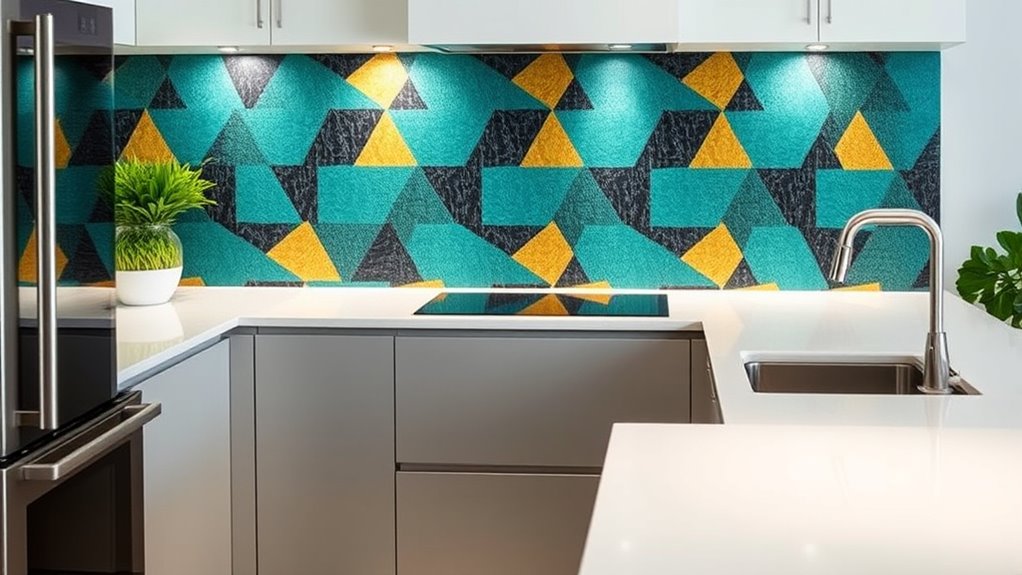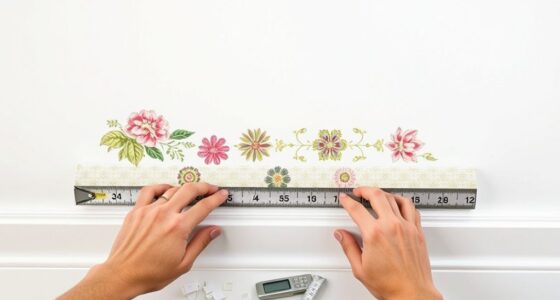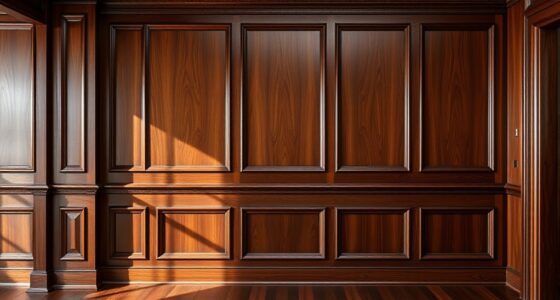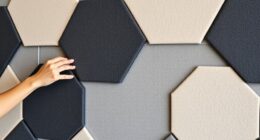When choosing wallpaper for your kitchen backsplash, pick patterns and colors that match your overall style, and opt for durable, moisture-resistant materials. Prep the surface thoroughly, ensuring it’s clean, smooth, and primed before application. Use the proper adhesive and work in small sections to avoid air bubbles. Seal and protect your wallpaper with waterproof coatings, and clean carefully to prevent damage. For lasting beauty and smart design tips, there’s more to explore below.
Key Takeaways
- Choose high-quality, moisture-resistant wallpaper designed for kitchen environments to ensure durability.
- Prepare the wall surface properly by cleaning, sanding, and applying a suitable primer before wallpaper installation.
- Use waterproof sealants or coatings to protect wallpaper from moisture, spills, and steam.
- Regularly clean with gentle, non-abrasive methods and inspect for damage to maintain longevity.
- Avoid mismatched patterns or colors that clash with your kitchen’s overall design, and consider using wallpaper as an accent.
Selecting the Right Wallpaper for Your Kitchen Backsplash

Choosing the right wallpaper for your kitchen backsplash can instantly enhance the space’s style and personality. When selecting a pattern, consider how it complements your overall kitchen design—bold patterns add drama, while subtle designs keep things understated. Pattern selection is essential to create visual interest without overwhelming the space. Equally important is color coordination; pick hues that harmonize with your cabinets, countertops, and overall color scheme. Light colors can brighten the room, while darker shades add depth. Remember, the wallpaper should reflect your style but also be practical for a kitchen setting. Avoid overly intricate patterns that may make cleaning difficult. Additionally, selecting quality materials can ensure your wallpaper remains durable and easy to maintain over time. Ultimately, a well-chosen wallpaper with thoughtful pattern and color coordination can transform your kitchen into a stylish, inviting space. Incorporating rustic decor elements can further enhance a cozy, farmhouse-inspired look that complements your wallpaper choice.
Preparing Your Surface for Wallpaper Application

Before applying wallpaper to your backsplash, it’s important to start with a clean, smooth surface. Remove any grease, dirt, or residue with a mild cleaner, as these can prevent proper adhesion. Lightly sand the area if needed to create a more even surface, especially if your wall has imperfections. When choosing wallpaper patterns, consider how they’ll look against your existing kitchen decor. One key factor is selecting the right adhesive types—some wallpapers require specific adhesives for durability and easy removal later. Use a primer if necessary to improve adhesion and prevent bubbling. Proper surface preparation ensures your wallpaper sticks securely and looks flawless, giving your kitchen a fresh, updated look without the mess or hassle down the line. Additionally, being aware of silly tantrums or unexpected pet antics can help you prepare for any last-minute surprises during the application process. To achieve the best results, understanding the contrast ratio of your wallpaper material can help you select options that enhance visual clarity and depth in your kitchen space. Moreover, understanding how prophetic dreams relate to subconscious processing can inspire more mindful planning for your decorating projects.
Proper Installation Techniques to Ensure Durability

To make sure your backsplash lasts, you need to focus on proper surface preparation and adhesive application. Clean and level the surface thoroughly before applying any materials, and use the right adhesive for your chosen alternative. When you follow these steps carefully, your installation will be more durable and resistant to everyday wear. Additionally, incorporating stabilization techniques during the application process can help maintain adhesion and prevent future damage. Ensuring proper surface preparation is especially important for materials like wallpaper, which can be sensitive to moisture and irregularities.
Surface Preparation Essentials
Ensuring a successful backsplash installation begins with proper surface preparation, as it directly impacts durability and adhesion. To start, focus on surface smoothing to create an even base free of bumps or rough patches. Next, choose the right primer selection to enhance adhesion and prevent peeling over time. Before applying wallpaper, thoroughly clean the surface to remove grease, dust, or debris. Additionally, verifying the signs of spoilage of any materials used can help maintain the integrity of your backsplash over time. Proper surface preparation techniques are crucial to prevent issues like peeling or bubbling. Being aware of adhesion principles can further ensure that your wallpaper or alternative backsplash adheres properly and lasts longer. Incorporating proper surface preparation methods can also help mitigate potential problems caused by environmental factors such as humidity or temperature fluctuations. Following these surface preparation essentials will help your wallpaper or alternative backsplash last longer and stay looking fresh.
Adhesive Application Tips
Proper adhesive application is essential for a durable backsplash, so take your time to apply the right amount of adhesive evenly across the surface. Use the appropriate adhesive types—such as mastic, thinset, or pre-mixed formulas—based on your wallpaper or material. Select the right application tools, like notched trowels or brushes, to ensure even coverage. Applying too much adhesive can cause bubbling or sagging, while too little may result in poor adhesion. Always work in small sections, pressing the wallpaper firmly to eliminate air pockets. Keep these key tips in mind:
| Adhesive Types | Application Tools | Tips |
|---|---|---|
| Mastic | Notched Trowel | Avoid excess, work in sections |
| Thinset | Brush or Roller | Keep adhesive consistent |
| Pre-mixed | Squeegee | Allow proper drying time |
| Specialty | Spatula | Check manufacturer instructions |
Sealing and Protecting Your Wallpaper From Moisture

Moisture is one of the biggest threats to wallpaper, especially in areas like the kitchen where splashes and humidity are common. To protect your wallpaper, you need to focus on sealing and moisture barriers. Here are four key steps:
- Apply a high-quality sealant, such as a clear acrylic or polyurethane, to create a moisture-resistant surface. This easy-to-apply solution provides an effective moisture barrier, extending the lifespan of your wallpaper.
- Use a waterproof primer beneath the wallpaper to act as an extra moisture barrier.
- Consider sealant options specifically designed for wallpapers, ensuring compatibility and durability.
- Regularly check for and repair any damage or gaps in the sealant to prevent moisture infiltration.
- Incorporate modern waterproofing techniques to monitor humidity levels and alert you to potential moisture issues before damage occurs.
Maintaining and Cleaning Your Wallpaper Backsplash

Keeping your wallpaper backsplash looking great is easy with regular dusting to remove dirt and prevent buildup. When stains appear, use gentle removal tips to avoid damaging the surface. To protect against moisture, consider waterproofing measures that keep your wallpaper safe and clean over time. Additionally, applying a protective coating can help maintain the wallpaper’s appearance and resist moisture damage. Incorporating sound healing techniques into your routine can also promote a relaxed mindset while maintaining your space. For added longevity, choosing moisture-resistant wallpapers can significantly reduce the risk of water damage in your kitchen area.
Regular Dusting Techniques
Regular dusting is essential to keep your wallpaper backsplash looking fresh and vibrant. It prevents dirt buildup and preserves its appearance over time. To maintain your wallpaper, establish simple dusting techniques and consistent cleaning schedules. Using HEPA filters in your vacuum can also help trap airborne dust particles, making your cleaning more effective. Here are four effective dusting techniques:
- Use a soft microfiber cloth to gently remove dust without damaging the surface.
- Attach a dusting brush to your vacuum for quick, thorough cleanings.
- Lightly dampen a cloth with water for stubborn dust or cobwebs.
- Regularly change cloths or filters to prevent spreading dirt.
Stick to a cleaning schedule—weekly or bi-weekly—to keep your wallpaper looking its best. Consistent dusting guarantees your backsplash stays vibrant and free of dust, extending its lifespan.
Stain Removal Tips
While routine dusting helps maintain your wallpaper backsplash, stains can still occur and require prompt attention. For effective stain removal, use gentle cleaning techniques to prevent damage. Blot spills immediately with a soft, damp cloth—don’t rub, as this spreads the stain. When cleaning, avoid harsh chemicals; instead, opt for mild soap and water or a mixture of vinegar and water. Test any cleaning solution on a small, hidden area first. For specific vehicle tuning applications, such as ECU remapping, ensure the cleaning process does not interfere with electronic components. Incorporating proper maintenance techniques can further extend the lifespan of your wallpaper, especially when using appropriate cleaning methods designed for delicate surfaces. Understanding emotional manipulation and how to recognize it can help you better protect your mental well-being. Consistent, careful stain removal preserves your wallpaper’s appearance.
Waterproofing Measures
To effectively maintain your wallpaper backsplash’s waterproofing, it’s essential to apply a protective sealant suited for wallpaper surfaces. This creates an effective moisture barrier against kitchen splashes and spills. Regularly inspecting the sealant guarantees it remains intact and functional. When cleaning, avoid abrasive scrubbers that can damage the waterproof layer. Instead, use a damp cloth with mild soap to wipe down the surface. Here are some key waterproofing measures:
- Reapply sealant every 1-2 years to maintain moisture barriers.
- Use a water-resistant coating designed specifically for wallpaper.
- Clean spills immediately to prevent water from seeping behind the wallpaper.
- Avoid prolonged exposure to steam or high humidity without re-sealing.
These steps help protect your wallpaper backsplash and prolong its lifespan while keeping it visually appealing.
Common Mistakes to Avoid With Wallpaper Basksplashes

One common mistake when using wallpaper backsplash is failing to properly prepare the surface beforehand. If the wall isn’t clean, smooth, and dry, the wallpaper may peel or bubble over time. Additionally, neglecting to contemplate design coordination can lead to a cluttered or mismatched look. You should choose a wallpaper that complements your cabinets, countertops, and overall kitchen style. Poor color matching can make the space feel disjointed or overwhelming. Always test the wallpaper in your kitchen’s lighting to ensure it harmonizes with your existing color palette. Proper preparation, thoughtful design coordination, and careful color matching are essential to avoid early damage or a disharmonious appearance. Recognizing the importance of digital literacy and maintaining transparency in relationships can help prevent emotional upheavals that might distract from home improvement projects. Taking these steps ensures your wallpaper backsplash remains attractive and durable.
Creative Ways to Incorporate Wallpaper Into Your Kitchen Design

Incorporating wallpaper into your kitchen design offers a fantastic opportunity to add personality and style beyond traditional backsplashes. To make the most of it, focus on creative placement and design. Here are some ideas:
- Use bold pattern choices on a single accent wall to create visual interest.
- Coordinate colors with your cabinets and countertops for a cohesive look.
- Apply wallpaper behind open shelving to showcase your favorite patterns.
- Consider smaller areas like the space above the sink or around the breakfast nook for a pop of color and texture.
Frequently Asked Questions
Can Wallpaper Be Removed Easily Without Damaging the Wall?
Yes, wallpaper can often be removed easily without damaging the wall if you used peel and stick type. To make removal smoother, guarantee proper wall prep before installation and peel slowly to avoid tearing. For traditional wallpaper, scoring and applying a removal solution can help, but it may sometimes damage the paint or drywall. Always test a small section first, and take your time to prevent wall damage during removal.
What Are the Best Types of Wallpaper for High-Moisture Kitchens?
For high-moisture kitchens, you should choose moisture resistant wallpaper like vinyl or coated fabric options. These materials withstand humidity and splashes better than traditional paper. Additionally, applying waterproof coatings or sealants can further protect your wallpaper from moisture damage. Avoid non-waterproof wallpapers, as they tend to peel or mold over time. When installed properly with these moisture-resistant options, your wallpaper can stay vibrant and intact in your kitchen.
How Long Does Wallpaper Typically Last as a Backsplash?
Wallpaper typically lasts 3 to 5 years as a backsplash, but durability concerns can shorten this lifespan. To maximize longevity, follow maintenance tips like sealing the wallpaper properly and avoiding excessive moisture exposure. Regular cleaning with gentle methods helps prevent damage. If you choose high-quality, moisture-resistant wallpaper, it can last longer. Keep an eye on peeling or discoloration, and be prepared to replace or reapply when signs of wear appear.
Is It Necessary to Use a Primer Before Wallpapering?
You might think skipping primer saves time, but it can threaten your wallpaper’s durability. Without it, your wallpaper could peel or bubble prematurely. Using a primer isn’t just a step—it’s a safeguard to make certain your wallpaper adheres properly and lasts longer. So, yes, primer is necessary for a smooth, durable finish. Don’t cut corners—invest in primer for a lasting, beautiful backsplash that stands the test of time.
Can Wallpaper Be Applied Over Existing Tiles or Paint?
Yes, you can apply wallpaper over existing tiles or paint, but it’s essential to guarantee good wallpaper durability and adhesive strength. Clean the surface thoroughly and repair any cracks or peeling paint. For tiles, use a primer to improve adhesion. Keep in mind, textured or glossy surfaces may reduce wallpaper sticking well. Proper preparation boosts the wallpaper’s longevity, so choose a high-quality adhesive and follow application instructions carefully.
Conclusion
Choosing wallpaper for your kitchen backsplash can transform your space into a canvas of creativity. With proper prep, installation, and care, your wallpaper can withstand the hustle and bustle of daily life. Think of it as a bold brushstroke on your home’s masterpiece—bringing warmth and personality. So, embrace the process and let your kitchen reflect your unique style. After all, a beautifully decorated space is like a warm hug you give yourself every day.









